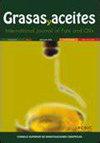利用实验设计优化湿阿萨伊果实酶法水提取油的回收率
IF 1.1
4区 农林科学
Q4 CHEMISTRY, APPLIED
引用次数: 0
摘要
在过去的几十年里,人们对阿萨伊果油的生物特性进行了广泛的研究,并获得了健康产业的关注。因此,有必要开发生态友好型提取技术。本研究的主要目的是采用实验设计,最大限度地提高从湿煎饼中提取阿萨伊油的酶法水提取工艺的回收率。在优化三种商用酶制剂的比例时,采用了简单网格混合设计。随后,采用中央复合设计确定了总酶浓度(0.5%-4.5%)和提取时间(2-12 小时)的最佳值。响应面方法"(RSM)显示,使用 Celluclast 1.5 L、Viscozyme L 和 Ultrazym AFP-L 的 0.49:0.25:0.28 三元混合物,总酶浓度为 2.85%,萃取时间为 10.9 小时,产量最高(60.55 ± 5.98%)。这项研究得出的结论是,水溶液酶法提取阿萨伊油是一种高效、可持续的工艺。本文章由计算机程序翻译,如有差异,请以英文原文为准。
Optimization of the recovery yield of the enzymatic aqueous extraction of oil from wet açaí decocts using Design of Experiment
These last decades, açaí oil has been extensively studied for its biological properties and has gained interest from the health industry. It has thus become necessary to develop eco-friendly extraction techniques. The main objective of this study was the use of experimental designs for the maximization of the recovery yield of the enzymatic aqueous extraction process of açaí oil from wet decocts. A Simplex-Lattice Mixture Design was employed for the optimization of the proportion of three commercial enzymatic preparations. Subsequently, a Central Composite Design was used to identify the optimal values for total enzymatic concentration (0.5-4.5%) and extraction time (2-12h). The “Response Surface Methodology” (RSM) revealed that the maximum yield (60.55 ± 5.98%) was obtained using a 0.49:0.25:0.28 ternary mixture of Celluclast 1.5 L, Viscozyme L and Ultrazym AFP-L at a total enzymatic concentration of 2.85% for 10.9 hours. This study concluded that the enzymatic aqueous extraction of açaí oil is an efficient and sustainable process.
求助全文
通过发布文献求助,成功后即可免费获取论文全文。
去求助
来源期刊

Grasas y Aceites
工程技术-食品科技
CiteScore
2.50
自引率
0.00%
发文量
50
审稿时长
3 months
期刊介绍:
Grasas y Aceites is a peer-reviewed journal devoted to the publication of original articles concerning the broad field of lipids, especially edible fats and oils from different origins, including non acyl lipids from microbial origin relevant to the food industry. It publishes full research articles, research notes, reviews as well as information on references, patents, and books.
Grasas y Aceites publishes original articles on basic or practical research, as well as review articles on lipid related topics in food science and technology, biology, (bio)chemistry, medical science, nutrition, (bio)technology, processing and engineering. Topics at the interface of basic research and applications are encouraged. Manuscripts related to by-products from the oil industry and the handling and treatment of the wastewaters are also welcomed.
Topics of special interest to Grasas y Aceites are:
-Lipid analysis, including sensory analysis
-Oleochemistry, including lipase modified lipids
-Biochemistry and molecular biology of lipids, including genetically modified oil crops and micro-organisms
-Lipids in health and disease, including functional foods and clinical studies
-Technical aspects of oil extraction and refining
-Processing and storage of oleaginous fruit, especially olive pickling
-Agricultural practices in oil crops, when affecting oil yield or quality
 求助内容:
求助内容: 应助结果提醒方式:
应助结果提醒方式:


